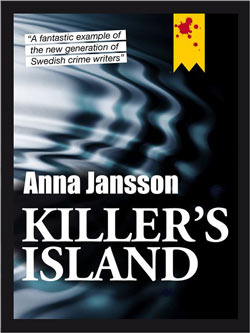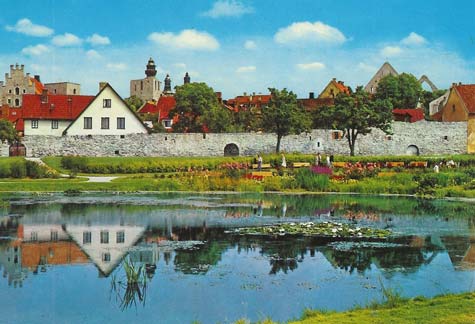 Killer’s Island is the English language debut of Anna Jansson’s Detective Inspector Maria Wern's police procedurals, beginning with Book 7 in the long-running Swedish series (available May 29, 2012).
Killer’s Island is the English language debut of Anna Jansson’s Detective Inspector Maria Wern's police procedurals, beginning with Book 7 in the long-running Swedish series (available May 29, 2012).
When I was in high school, I worked two summers at a nearby theme park. Like the residents of the historic medieval town of Visby, I know that vacationers don’t necessarily overflow with surplus fun and joy for those serving them. While they frolic, you’re on the clock, and among things park employees perceive differently is the scenery, because they know behind which ornamental shrubbery are the exits to the utility corridors, the functional arteries of people and materials that serve the backstage of the park.
Set on the Swedish island of Gotland, Visby has just over 20,000 full-time residents, but many more than that descend from ferries every summer, and especially during Medieval Week in August. (In another recent Fresh Meat of Swedish crime, Jordan Foster discussed the undeniable attractions of Visby from the traveler’s point of view.) However, D.I. Maria Wern deals with these visitors as ugly business more than pleasure, totting up the property damage, thefts, and violent crime. The characters of this novel—full-time residents—transit a functional circuit between their lonely homes, the police station, and most often, the hospital.
In early June, Maria Wern goes out drinking with a colleague, forensic technician Erika Lund. Erika tarries with a doctor she’s met, Anders Ahlström, so Maria takes off her painfully cute high heels and walks home alone. On the way down Ryska Gränd (Russian Alley), toward the Cathedral which I learned is the only intact church after a sacking fire in 1525, she encounters a group of three men kicking the life out of an adolescent boy. Maria isn’t armed, and doesn’t even seem to have a hotline number to get past the police switchboard. She calls for help, is put on hold, and to save the boy, ends up throwing herself across him and taking abuse with steel-toed boots and being stabbed with what looks like a blood-filled syringe. She rouses from unconsciousness in the hospital to learn the boy hasn’t survived. This is awful enough, but among Visby residents, even people who haven’t been beaten or had loved ones murdered seem unssatisfied with their lots in life.

Scenery doesn’t make up for the emotional support Maria needs and doesn’t get from her boyfriend, also a cop, Per Arvidsson, who hasn’t been the same since he was shot on duty. Her friend Erika wants to get closer to Anders, but he has a spoiled young daughter and the guilty memory of his wife’s drowning on the night of their marriage (when their daughter, Julia, was six months old) that echoes an eerie old legend about a vengeful mermaid. About this local ghost, the White Sea-Lady, a bride of the deeps, there will be much more.
In Anders’s practice, he treats hospital nurse Linn Bogron, a conflicted married woman who’s fallen in love with a lung transplant patient, Sara, and who wants no help but sleeping pill prescriptions after she’s harassed and groped by three men outside her home. Harry Molin is Anders’s most hypochondriac patient and Linn’s neighbor, whose dogs saved her from a far worse fate, the reader is sure. And did I mention that depressed cop-on-disability Per Arvidsson lives across the lane from them both? And that Erika’s rental cottage is next door to ex-patient Sara’s? There is the oppression of a smaller, inner community living in each other’s pockets and unhappily at that. As one character says, “Sometimes I think people try to be satisfied with the crumbs from the table because that’s all they feel they’re worth . . . .”
But the pervasive sense of unsettled anxiety is not all manufactured, for in fact, these residents are each being observed. Anders’s secret smoking habit is watched and judged from eyes inside the hospital. Outside Erika’s artist’s cottage with its charming hammock, she feels the need to turn away when speaking on the phone so neighbor Sara won’t overhear. Linn is tormented by a face she sees peeking through her window and can’t rest while listening for noises of her neighbors in the garden. But beyond all these is another observer:
It had been child’s play hacking into the Russian satellite that monitored the gas pipeline near Gotland. That its reception was so technically advanced came as a surprise. When weather conditions were favorable he could even watch their unsuspecting faces. This, perhaps, gave him more satisfaction than anything else.
And while the vital business of pleasure grinds on in this resort town, more grotesqueries unfold:
Monday morning was clean and fresh with dew. Maybe slightly on the cool side, at least in the opinion of the visitors who had assembled in the Botanical Gardens to listen to the flute-playing gardener . . . A discussion started up about the installations which a number of artists had exhibited in and around Visby in the lead-up to the tourist season this year and in years before. Could telephone booths submerged in water really be considered as art? Or giant fried eggs in the town square? Are barcodes tattooed on someone’s bottom really an expression of art? . . . None of those who witnessed it would ever forget the horrendous sight that awaited them in the pavilion. The soft vegetation and early summer blooms had lured them into a false sense of security . . . The screams could be heard all the way to the Ordnance Tower.
Visby? Some vacation!
Image via Torgil Jarnling’s postcards.
Clare Toohey is Clare2e here and also at Women of Mystery. She had a mildly amusing, surreal crime story appear in Murder New York Style: Fresh Slices. She’s an omnivorous literary grazer who wants a taste from your plate.
See all of Clare Toohey’s posts at Criminal Element.
